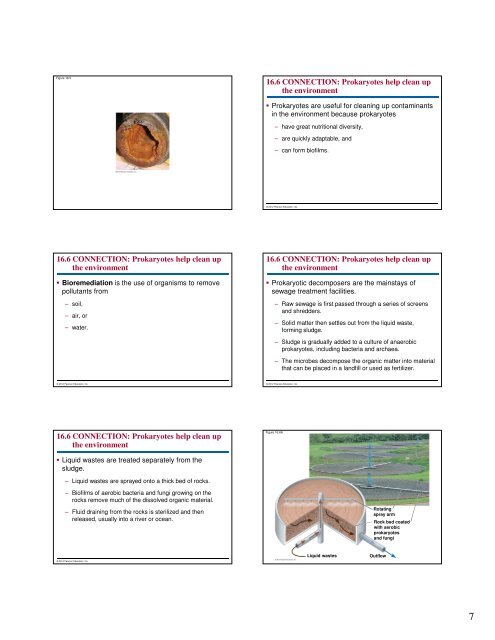Microbial Life: Prokaryotes and Protists - Renz Science
Microbial Life: Prokaryotes and Protists - Renz Science
Microbial Life: Prokaryotes and Protists - Renz Science
You also want an ePaper? Increase the reach of your titles
YUMPU automatically turns print PDFs into web optimized ePapers that Google loves.
Figure 16.516.6 CONNECTION: <strong>Prokaryotes</strong> help clean upthe environment <strong>Prokaryotes</strong> are useful for cleaning up contaminantsin the environment because prokaryotes– have great nutritional diversity,– are quickly adaptable, <strong>and</strong>– can form biofilms.© 2012 Pearson Education, Inc.16.6 CONNECTION: <strong>Prokaryotes</strong> help clean upthe environment Bioremediation is the use of organisms to removepollutants from– soil,– air, or– water.16.6 CONNECTION: <strong>Prokaryotes</strong> help clean upthe environment Prokaryotic decomposers are the mainstays ofsewage treatment facilities.– Raw sewage is first passed through a series of screens<strong>and</strong> shredders.– Solid matter then settles out from the liquid waste,forming sludge.– Sludge is gradually added to a culture of anaerobicprokaryotes, including bacteria <strong>and</strong> archaea.– The microbes decompose the organic matter into materialthat can be placed in a l<strong>and</strong>fill or used as fertilizer.© 2012 Pearson Education, Inc.© 2012 Pearson Education, Inc.16.6 CONNECTION: <strong>Prokaryotes</strong> help clean upthe environmentFigure 16.6A Liquid wastes are treated separately from thesludge.– Liquid wastes are sprayed onto a thick bed of rocks.– Biofilms of aerobic bacteria <strong>and</strong> fungi growing on therocks remove much of the dissolved organic material.– Fluid draining from the rocks is sterilized <strong>and</strong> thenreleased, usually into a river or ocean.Rotatingspray armRock bed coatedwith aerobicprokaryotes<strong>and</strong> fungi© 2012 Pearson Education, Inc.Liquid wastesOutflow7


